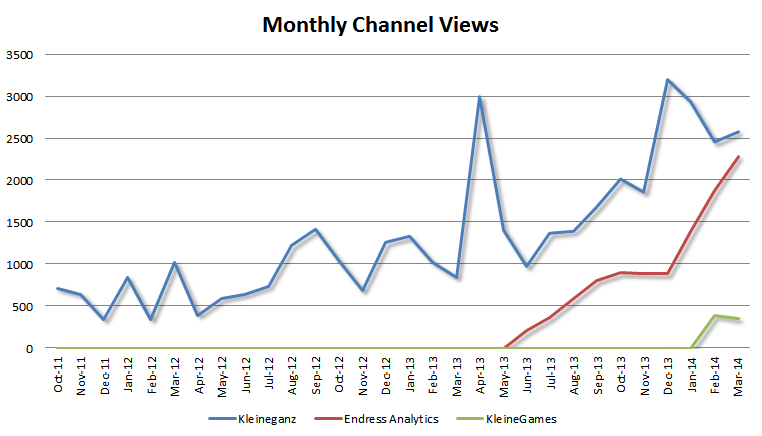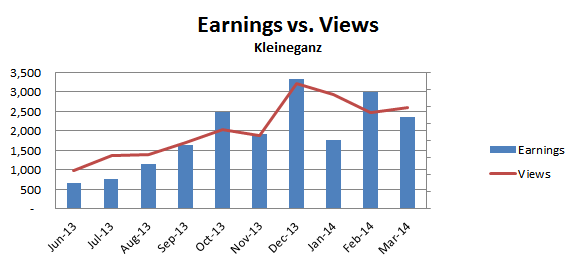I have been producing YouTube videos now for roughly 2.5 years. In that time I’ve launched 3 separate channels, each with it’s own unique focus. The oldest channel I use for posting personal vlogs (video blogs), and for a time I was also posting gaming videos as well. The next channel I launched about a year ago in order to do Analytics tutorials as well as provide news and reviews related to the Analytics community. The newest channel was launched this past January, and is completely focused on gaming videos (I decided to stop posting them on what’s now exclusively my vlog channel). Naturally each of these channels has a very specific target audience, and that is reflected somewhat in how each performs.
As you can see the “Kleineganz” channel (which is the oldest) has shown steady growth over the past 2.5 years since it’s launch. The various spikes that are seen come from the occasional paid marketing campaigns. The “EndressAnalytics” channel, which much younger, has taken off much more steeply and shows very strong growth. There are no spikes because I have not felt the need to do any paid marketing campaigns for that channel yet. The youngest channel “KleineGames” was just started in January of this year and doesn’t really have enough data to properly analyze at this time.
Looking at each channel individually, and comparing earnings to views, some interesting patterns emerge. Looking at the vlog channel, generally as views go up, so do earnings. However, in February 2014, we can see a spike in earnings despite a dip in views. Digging deeper into the data, I found that my CPM (cost-per-mille, or earnings per 1,000 “monetizable views”) increased that month.
Shifting focus to the analytics tutorial channel, while comparing earnings to views, earnings clearly spiked in January 2014, and then dropped in February and March. However views have continued to increase. Going back to the CPM, it nearly doubled in January before coming back down to more normal levels. Also in January, the percentage of “monetizable views” increased (not all views are monetizable due to the fact that some views come from viewers using adblock, or from countries where monetization/ads are not accepted). The increased CPM and higher monetization rate had a combined effect on the earnings for that month.
Lastly, we’ll look at the gaming channel, which was launched in January. There was a clear spike in views, without a comparative spike in earnings, during the first month the channel existed. This is due to the fact that an un-monetized video was being used for a paid advertising campaign (in order to increase awareness of the new channel). The video received a lot of views, and a small percentage of them went on to view other videos, accounting for the small earnings that month. The following month had an opposite occurrence. There was no advertising that month, and so the views dropped, while earnings increased. Once again there was a combined effect of an increased CPM and increased monetization rate that resulted in the increased earnings in February.
Overall the CPM rates vary widely across each channel (however I am not at liberty to disclose the exact CPM rates I get on my channel due to an NDA that I signed with Google). The analytics channel earns by far the highest CPM rates, and also has the highest monetization rates. This is a direct result of the quality and type of ads those videos receive. Because it is a more business-focused channel, it attracts higher-paying, business-focused ads. The ads for the other two channels are focused at a more general audience, and therefore have lower CPMs and also lower monetization rates, primarily due to those target audiences being more likely to use AdBlock in order to block the ads playing.
I hope this article gives some insight into data analysis for YouTube channels. I purposely pull the data out of YouTube Analytics, into Excel, in order to provide a more in-depth analysis for myself beyond what is capable within the YouTube analytics tool, which I still find woefully inadequate.




